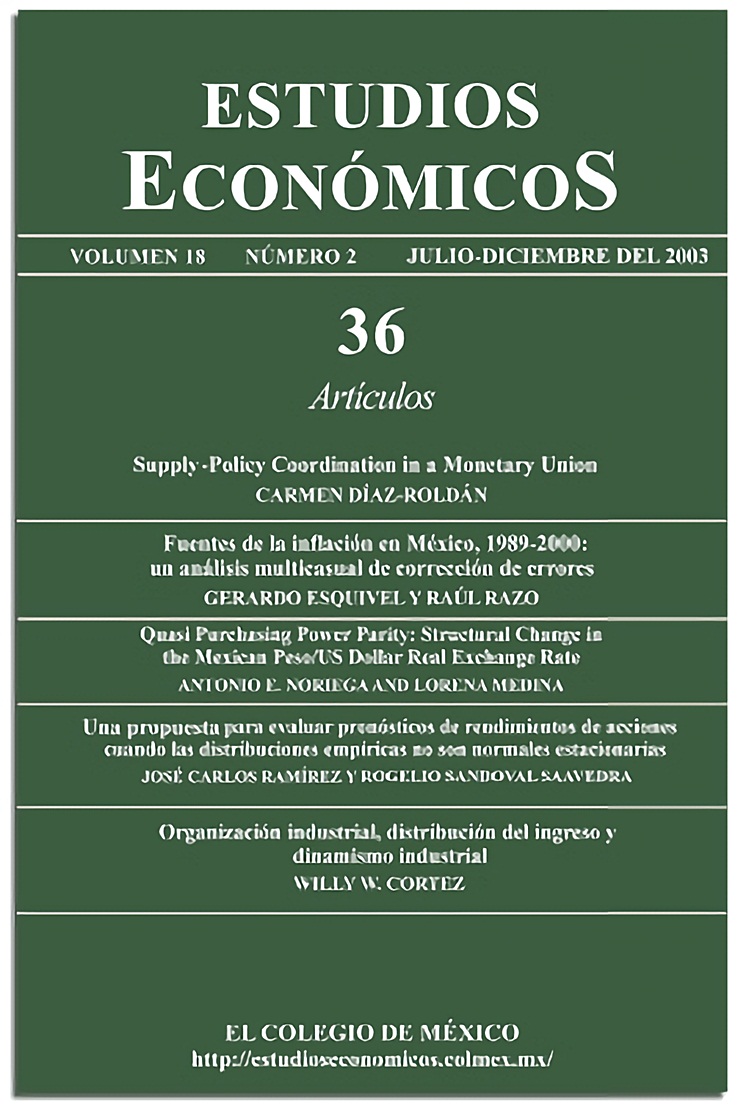Articles
Quasi purchasing power parity: Structural change in the Mexican peso/US dollar real exchange rate
Published 2003-07-01
Keywords
- exchange-rate,
- mexican peso,
- american dollar,
- purchasing power
How to Cite
Noriega, A. E., & Medina, L. (2003). Quasi purchasing power parity: Structural change in the Mexican peso/US dollar real exchange rate. Estudios Económicos De El Colegio De México, 18(2), 227–236. https://doi.org/10.24201/ee.v18i2.183
Abstract
This paper analyzes whether the real exchange-rate of the Mexican peso/US dollar revert to a long-run equilibrium value, and whether this value is unique. We use a method for testing stationarity, that allows for an unknown number of structural breaks in the level of the series. Using a long span of annual data covering the period 1925-1994, our results provide evidence favoring long-run Quasi-Purchasing Power Parity. In particular, we find that the real peso/dollar exchange rate has fluctuated stationarily around a 70 year long-run level, perturbed by a series of events, both domestic and external, in or around 1981.
Downloads
Download data is not yet available.
References
- Aggarwal, R., A. Montañés and M. Ponz (2000). “Evidence of Long-run Purchasing Power Parity: Analysis of Real Asian Exchange Rates in Terms of the Japanese Yen”, Japan and the World Economy, 12, pp. 351-361.
- Alzati, F. A. (1997). The Political Economy of Growth in Modern Mexico, PhD Thesis, Harvard University.
- Andrews, D. W. K. (1993). “Tests for Parameter Instability and Structural Change with Unknown Change Point”, Econometrica, 61 (4), pp. 821-856.
- Arestis, P. and I. Biefang-Frisancho (1999). “Unit Roots and Structural Breaks in OECD Unemployment”, Economics Letters, 65, pp. 149-156.
- Aspe, P. (1993). El camino mexicano de la transformación económica, second edition, México, FCE.
- Avalos, A. and F. Hernández (1995). “Comportamiento del tipo de cambio real y desempeño económico en México”, Economía Mexicana, vol. IV, no. 2, pp. 239-263.
- Bai, J. (1999). “Likelihood Ratio Tests for Multiple Structural Changes”, Journal of Econometrics, 91, pp. 299-323.
- Bai, J. (1997a). “Estimating Multiple Breaks One at a Time”, Econometric Theory, 13 (3), pp. 315-352.
- Bai, J. (1997b). “Estimation of a Change Point in Multiple Regression Models”, The Review of Economics and Statistics, 79 (4), pp. 551-563.
- Bai, J. and P. Perron (1998a). “Estimating and Testing Linear Models with Multiple Structural Changes”, Econometrica, 66 (1), pp. 47-48.
- Bai, J. and P. Perron (1998b). Computation and Analysis of Multiple Structural Change Models, (mimeo).
- Baum C. F., J. T. Barkoulas, and M. Caglayan (1999). “Long Memory or Structural Breaks: Can Either Explain Nonstationary Real Exchange Rates under the Current Float?”, Journal of International Financial Markets, Institutions and Money, 9, pp. 359-376.
- Clemente, J., A. Montañéz and M. Reyes (1998). “Testing for a Unit Root in Variables with a Double Change in the Mean”, Economics Letters, 59, pp. 175-182.
- Corbae, D. and S. Ouliaris (1991). “A Test of long-run Purchasing Power Parity Allowing for Structural Breaks”, Economic Record, 67, pp. 26-33.
- Culver, S. and D. Papell (1995). “Real Exchange Rates under the Gold Standard: Can they be Explained by the Trend Break Model?”, Journal of International Money and Finance, 14, no. 4, pp. 539-548.
- Galindo, L. (1995). “Una nota sobre el tipo de cambio en México”, Investigación Económica, no. 212.
- Hegwood, N. D. and D. Papell (1998). “Quasi Purchasing Power Parity”, International Journal of Finance and Economics, 3, pp. 279-289.
- Hendry, D. and A. J. Neale (1990). A Monte Carlo Study of the Effects of Structural Breaks on Tests for Unit Roots, Nuffield College, Oxford, (mimeo).
- Kuo, B. and A. Mikkola (1999). “Re-examining Long-run Purchasing Power Parity”, Journal of International Money and Finance, 18, pp. 251-266.
- Mehl, A. (2000). “Unit Root Tests with Double Trend Breaks and the 1990s Recession in Japan”, Japan and the World Economy, 12, pp. 363-379.
- Mejía P., and J. C. González (1996). “La paridad del poder de compra en el largo plazo: El caso de México”, Economía Mexicana, vol. 5, no. 1, pp. 37-62.
- Noriega, A. E. and A. Ramírez-Zamora (1999). “Unit Roots and Multiple Structural Breaks in Real Output: How Long Does an Economy Remain Stationary?”, Estudios Económicos. Vol. 14, no. 2, pp. 163-188.
- Ohara, H. I. (1999). “A Unit Root Test with Multiple Trend Breaks: A Theory and an Application to US and Japanese Macroeconomic Time-Series”, The Japanese Economic Review, 50 (3), pp. 266-290.
- Perron, P. (1997). “Further Evidence on Breaking Trend Functions in Macroeconomic Variables”, Journal of Econometrics, 80, pp. 355-385.
- Perron, P. (1989). “The Great Crash, the Oil Price Shock, and Unit Root Hyphotesis”, Econometrica, 57, pp. 1361-1401.
- Perron, P. and T. Vogelsang (1992). “Nonstationary and Level Shifts with an Application to Purchasing Power Parity”, Journal of Business and Economic Statistics, 10, no. 3, pp. 301-320.
- Reichlin, L. (1989). “Structural Change and Unit Root Econometrics”, Economics Letters, 31, pp. 231-233.
- Steigerwald, D. G. (1996). “Purchasing Power Parity, Unit Roots, and Dynamic Structure”, Journal of Empirical Finance, 2, pp. 343-357.

